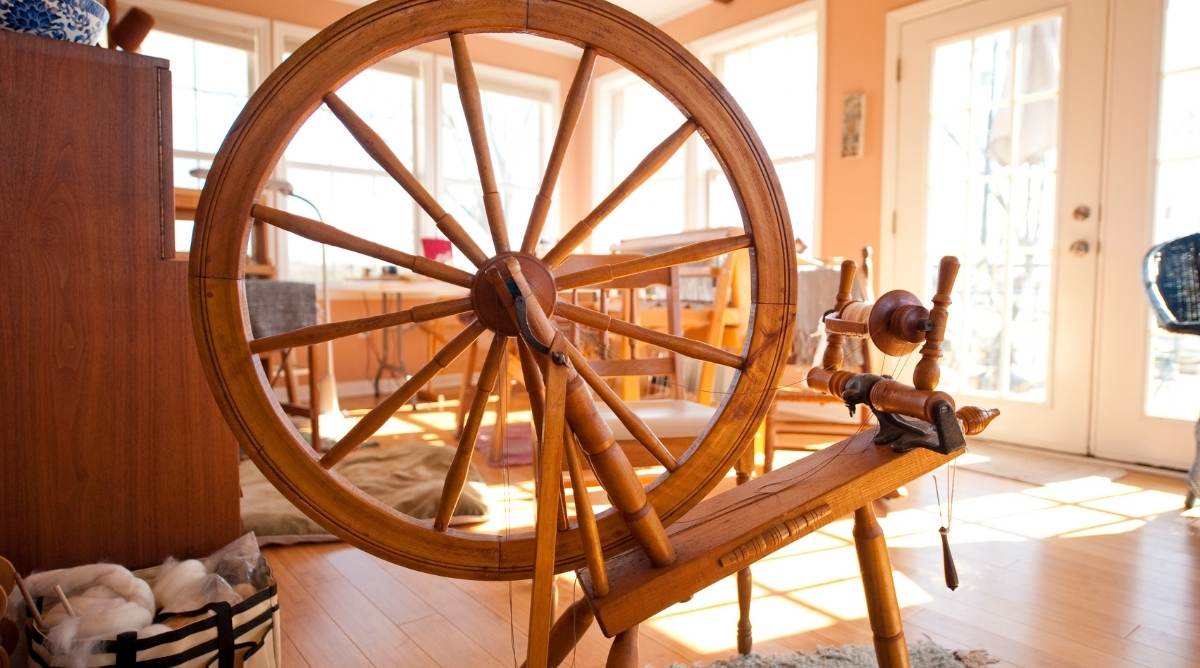To use a spinning wheel, a spinner places scrap yarn around the bobbin and through the flyer hooks. They then rotate the wheel by treadling and using their hands to control the thickness and twist of the spun yarn.
Table of Contents
How does a spinning wheel work?
Here’s a step-by-step explanation of how to use a spinning wheel:
- Set the spinning wheel up by placing the bobbin onto your flyer and screwing on the whirl.
- Insert the flyer into your mother-of-all.
- Place one string on the bobbin and one on the whirl.
- Make sure the bobbin spins freely inside the flyer.
- Wrap the scrap yarn around the bobbin tightly so it doesn’t slip.
- Pull the yarn through the hooks on the flyer.
- Adjust the bobbin and test how it pulls the yarn.
- Lay the roving onto the lead yarn.
- Start the wheel, making the roving twist onto the starter yarn.
- Pull pieces of roving forward and start spinning, pressing the treadle with your feet to move the wheel.
What is the purpose of a spinning wheel?
The purpose of the spinning wheel is to turn fibers into yarn. It’s believed the device was invented in India between 500 and 1000 AD.
Before the invention of the spinning wheel as we know it, spinners used a small and portable wheel called Charkha.
The spinning jenny revolutionized yarn production by spinning multiple spindles at once. It was invented by James Hargreaves in 1764 and helped revolutionize cotton spinning and expand wool production. The spinning jenny was developed in the midst of the Industrial Revolution and was the beginning of the early modern yarn production system.
Components of a spinning wheel

Spinning wheels have the following components:
- a single or double treadle (a pedal moved by feet turning the wheel)
- flyers (allow continuous spinning)
- bobbins (wooden spools mounted on the flyer shaft)
- drive wheels (drive the bobbin)
- drive bands (turn the flyer)
- whorls (pulleys that turn the bobbins, running the drive band)
- maidens (hold the flyer and bobbin)
- tension (a belt system)
- mother-of-all (the bar that holds the maidens, flyer, bobbin, and tension knob)
What types of spinning wheels are there?
There are various styles or types of spinning wheels, such as:
- Charkha wheels
- Saxony spinning wheels (also called “fairytale” wheels)
- Norwegian wheels (similar to Saxony, with a large wheel)
- Great Wheels
- spindle wheels
- single drive wheels
- double-drive wheels
- bobbin lead wheels
- castle spinning wheels
- flyer-driven spinning wheels
- electric spinners
- modern wheels
Learning how to use a spinning wheel

Spinning yarn is a skill, and the wheels are complex, so don’t get discouraged if you don’t get the desired result the first couple of times. Here’s some advice on learning to use your spinning wheel:
- Make sure your wheel is properly assembled and has all the necessary parts. The components may vary depending on the wheel type. For instance, you may have a single or double treadle wheel, so you will use one or two feet. It’s best not to use shoes to avoid transferring dirt onto the treadles.
- Get the basics right. Experiment with your spinning fiber. You’ll likely test and adjust a lot to get used to how it all works.
- Practice treadling to keep the wheel turning at a constant speed. Don’t go too slow or too fast. The wheel should always be turning in one direction. Typically, it’s clockwise for single threads (Z twist) and counterclockwise for combined threads called plies (S twist).
- Mastering spinning wheel tension is also key. Keep in mind that there are two types of tension: Scotch tension and Irish tension. Scotch tension has the brake band on the bobbin and the drive band on the flyer whorl. In Irish tension spinning wheels, the drive band is on the bobbin whorl and the tension band is on the flyer.
- You may have a single or double-drive spinning wheel, and this can affect what type of yarn you can spin best. A single drive wheel has one drive band around the flyer wheel and is recommended for handspinner beginners. Once you’ve gotten a handle of handspinning, feel free to try the double-drive wheel.

